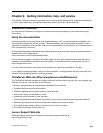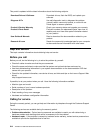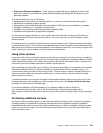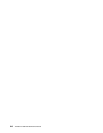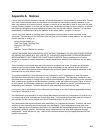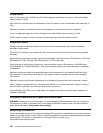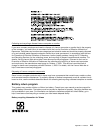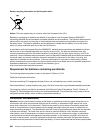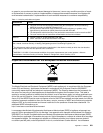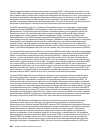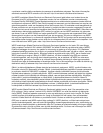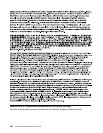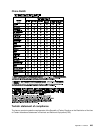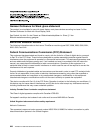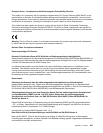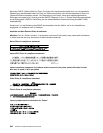
or gases in your environment have caused damage to the server, Lenovo may condition provision of repair
or replacement of servers or parts on implementation of appropriate remedial measures to mitigate such
environmental contamination. Implementation of such remedial measures is a customer responsibility.
Table 1. Limits for particulates and gases
Contaminant Limits
Particulate
• The room air must be continuously ltered with 40% atmospheric dust spot efciency
(MERV 9) according to ASHRAE Standard 52.2
1
.
• Air that enters a data center must be ltered to 99.97% efciency or greater, using
high-efciency particulate air (HEPA) lters that meet MIL-STD-282.
• The deliquescent relative humidity of the particulate contamination must be more than 60%
2
.
• The room must be free of conductive contamination such as zinc whiskers.
Gaseous • Copper: Class G1 as per ANSI/ISA 71.04-1985
3
• Silver: Corrosion rate of less than 300 Å in 30 days
1
ASHRAE 52.2-2008 - Method of Testing General Ventilation Air-Cleaning Devices for Removal Efciency by Particle
Size. Atlanta: American Society of Heating, Refrigerating and Air-Conditioning Engineers, Inc.
2
The deliquescent relative humidity of particulate contamination is the relative humidity at which the dust absorbs
enough water to become wet and promote ionic conduction.
3
ANSI/ISA-71.04-1985. Environmental conditions for process measurement and control systems: Airborne
contaminants. Instrument Society of America, Research Triangle Park, North Carolina, U.S.A.
Important information for the European Directive 2002/96/EC
EU Only
The Waste Electrical and Electronic Equipment (WEEE) mark applies only to countries within the European
Union (EU) and Norway. Appliances are labeled in accordance with European Directive 2002/96/EC
concerning waste electrical and electronic equipment (WEEE). The Directive determines the framework for
the return and recycling of used appliances as applicable throughout the European Union. This label is
applied to various products to indicate that the product is not to be thrown away, but rather reclaimed upon
end of life per this Directive. Users of electrical and electronic equipment (EEE) with the WEEE marking per
Annex IV of the WEEE Directive must not dispose of end of life EEE as unsorted municipal waste, but use the
collection framework available to them for the return, recycle, recovery of WEEE and minimize any potential
effects of EEE on the environment and human health due to the presence of hazardous substances. For
additional WEEE information go to:
http://www.lenovo.com/lenovo/environment
Le marquage des déchets d'équipements électriques et électroniques (DEEE) s'applique uniquement aux
pays de l'Union européenne (EU) et à la Norvège. Les appareils sont marqués conformément à la Directive
2002/96/CE du Conseil Européen relative aux déchets d'équipements électriques et électroniques (DEEE).
Cette directive, applicable à l'ensemble des pays de l'Union européenne, concerne la collecte et le recyclage
des appareils usagés. Ce marquage est apposé sur différents produits pour indiquer que ces derniers
ne doivent pas être jetés, mais récupérés en n de vie, conformément à cette directive. Les utilisateurs
Appendix A. Notices 221



